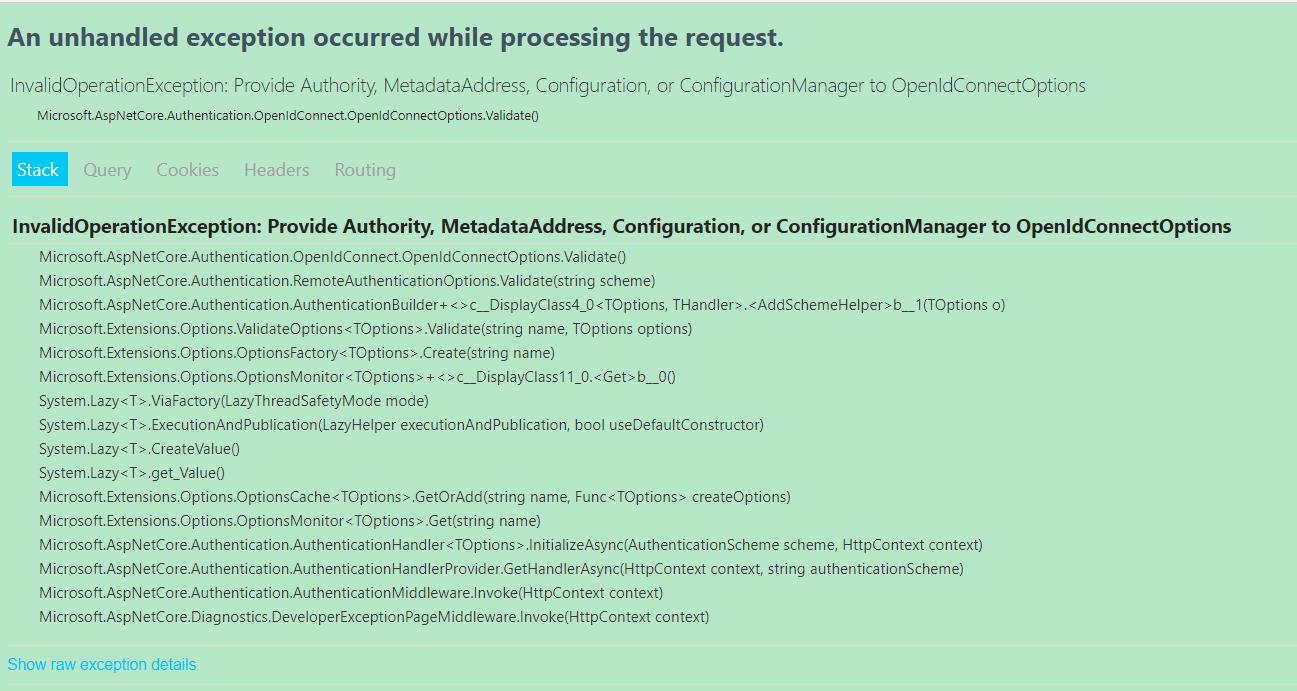1.Xshell遠程登錄Linux系統 在實際的項目部署工作中,遠程登錄到伺服器上是繞不開的彎。本文遠程登錄Linux系統選用工具的是目前最常用、最好用的Xshell。Xsheel是一個強大的安全終端模擬軟體,它支持SSH1、SSH2以及Windows系統的Telnet協議。它的運行速度流程並且完美 ...
在使用Identity Server作Identity Provider的時候,我們在NetCore的ConfigureServices((IServiceCollection services))方法中,常需要指定options的Authority,如下代碼所示:
public void ConfigureServices(IServiceCollection services)
{
services.AddControllersWithViews();
//
#region MVC client
//關閉了 JWT 身份信息類型映射
//這樣就允許 well-known 身份信息(比如,“sub” 和 “idp”)無干擾地流過。
//這個身份信息類型映射的“清理”必須在調用 AddAuthentication()之前完成
JwtSecurityTokenHandler.DefaultInboundClaimTypeMap.Clear();
services.AddAuthentication(options =>
{
options.DefaultScheme = "Cookies";
options.DefaultChallengeScheme = "oidc";
})
.AddCookie("Cookies")
.AddOpenIdConnect("oidc", options =>
{
options.Authority = "http://localhost:5001";
options.RequireHttpsMetadata = false;
options.ClientId = "code_client";
//Client secret
options.ClientSecret = "511536EF-F270-4058-80CA-1C89C192F69A".ToString();
//code方式
options.ResponseType = "code";
//Scope可以理解為申請何種操作範圍
options.Scope.Add("code_scope1"); //添加授權資源
options.SaveTokens = true;
options.GetClaimsFromUserInfoEndpoint = true;
});
#endregion
services.ConfigureNonBreakingSameSiteCookies();
}
其中options.Authority = "http://localhost:5001"需要設置,如果把它註釋掉,則會報如下的錯誤,從這個異常看得出來,應該是Authority沒有設置:

那麼為什麼我們一定要設置.Authority 呢?我們一步一步來看看:
1.在調用services.AddOpenIdConnect方法時,實質調用的是OpenIdConnectExtensions靜態類的AddOpenIdConnect靜態方法,如下所示:
public static AuthenticationBuilder AddOpenIdConnect(this AuthenticationBuilder builder, string authenticationScheme, string? displayName, Action<OpenIdConnectOptions> configureOptions)
{
builder.Services.TryAddEnumerable(ServiceDescriptor.Singleton<IPostConfigureOptions<OpenIdConnectOptions>, OpenIdConnectPostConfigureOptions>());
return builder.AddRemoteScheme<OpenIdConnectOptions, OpenIdConnectHandler>(authenticationScheme, displayName, configureOptions);
}
2.從上面的代碼看得出,實際上調用的是AuthenticationBuilder的AddRemoteScheme擴展方法,如下所示:
/// <summary>
/// Adds a <see cref="AuthenticationScheme"/> which can be used by <see cref="IAuthenticationService"/>.
/// </summary>
/// <typeparam name="TOptions">The <see cref="AuthenticationSchemeOptions"/> type to configure the handler."/>.</typeparam>
/// <typeparam name="THandler">The <see cref="AuthenticationHandler{TOptions}"/> used to handle this scheme.</typeparam>
/// <param name="authenticationScheme">The name of this scheme.</param>
/// <param name="displayName">The display name of this scheme.</param>
/// <param name="configureOptions">Used to configure the scheme options.</param>
/// <returns>The builder.</returns>
public virtual AuthenticationBuilder AddScheme<TOptions, [DynamicallyAccessedMembers(DynamicallyAccessedMemberTypes.PublicConstructors)]THandler>(string authenticationScheme, string? displayName, Action<TOptions>? configureOptions)
where TOptions : AuthenticationSchemeOptions, new()
where THandler : AuthenticationHandler<TOptions>
=> AddSchemeHelper<TOptions, THandler>(authenticationScheme, displayName, configureOptions);
private AuthenticationBuilder AddSchemeHelper<TOptions, [DynamicallyAccessedMembers(DynamicallyAccessedMemberTypes.PublicConstructors)]THandler>(string authenticationScheme, string? displayName, Action<TOptions>? configureOptions)
where TOptions : AuthenticationSchemeOptions, new()
where THandler : class, IAuthenticationHandler
{
Services.Configure<AuthenticationOptions>(o =>
{
//註冊Scheme對應的HandlerType
o.AddScheme(authenticationScheme, scheme => {
scheme.HandlerType = typeof(THandler);
scheme.DisplayName = displayName;
});
});
if (configureOptions != null)
{
Services.Configure(authenticationScheme, configureOptions);
}
//Options驗證
Services.AddOptions<TOptions>(authenticationScheme).Validate(o => {
o.Validate(authenticationScheme);
return true;
});
Services.AddTransient<THandler>();
return this;
}
看得出來,實際上調用的是AddSchemeHelper方法,在這個方法里,有一個很重要的Options驗證:
Services.AddOptions<TOptions>(authenticationScheme).Validate(o => { o.Validate(authenticationScheme); return true; });
在這裡需要對AuthenticationSchemeOptions進行驗證
3.上一步的Options驗證中實際上調用的是OpenIdConnectOptions類的Validate方法,如下所示:
/// <summary>
/// Check that the options are valid. Should throw an exception if things are not ok.
/// </summary>
public override void Validate()
{
base.Validate();
if (MaxAge.HasValue && MaxAge.Value < TimeSpan.Zero)
{
throw new ArgumentOutOfRangeException(nameof(MaxAge), MaxAge.Value, "The value must not be a negative TimeSpan.");
}
if (string.IsNullOrEmpty(ClientId))
{
throw new ArgumentException("Options.ClientId must be provided", nameof(ClientId));
}
if (!CallbackPath.HasValue)
{
throw new ArgumentException("Options.CallbackPath must be provided.", nameof(CallbackPath));
}
//如果Authority沒有設置,則報下麵這個異常
if (ConfigurationManager == null)
{
throw new InvalidOperationException($"Provide {nameof(Authority)}, {nameof(MetadataAddress)}, "
+ $"{nameof(Configuration)}, or {nameof(ConfigurationManager)} to {nameof(OpenIdConnectOptions)}");
}
}
從這裡看得出來,如果ConfigurationManager為空,則就會報前面中的異常了,所以異常就是這麼來的。
4.那麼為什麼ConfigurationManager為空呢?我們回顧OpenIdConnectExtensions的AddOpenIdConnect方法:
public static AuthenticationBuilder AddOpenIdConnect(this AuthenticationBuilder builder, string authenticationScheme, string? displayName, Action<OpenIdConnectOptions> configureOptions)
{
builder.Services.TryAddEnumerable(ServiceDescriptor.Singleton<IPostConfigureOptions<OpenIdConnectOptions>, OpenIdConnectPostConfigureOptions>());
return builder.AddRemoteScheme<OpenIdConnectOptions, OpenIdConnectHandler>(authenticationScheme, displayName, configureOptions);
}
看得出AuthenticationBuilder的Services添加了一個名為OpenIdConnectPostConfigureOptions的單例服務: builder.Services.TryAddEnumerable(ServiceDescriptor.Singleton<IPostConfigureOptions<OpenIdConnectOptions>, OpenIdConnectPostConfigureOptions>());
繼續看下OpenIdConnectPostConfigureOptions的源碼:
/// <summary>
/// Invoked to post configure a TOptions instance.
/// </summary>
/// <param name="name">The name of the options instance being configured.</param>
/// <param name="options">The options instance to configure.</param>
public void PostConfigure(string name, OpenIdConnectOptions options)
{
options.DataProtectionProvider = options.DataProtectionProvider ?? _dp;
if (string.IsNullOrEmpty(options.SignOutScheme))
{
options.SignOutScheme = options.SignInScheme;
}
if (options.StateDataFormat == null)
{
var dataProtector = options.DataProtectionProvider.CreateProtector(
typeof(OpenIdConnectHandler).FullName!, name, "v1");
options.StateDataFormat = new PropertiesDataFormat(dataProtector);
}
if (options.StringDataFormat == null)
{
var dataProtector = options.DataProtectionProvider.CreateProtector(
typeof(OpenIdConnectHandler).FullName!,
typeof(string).FullName!,
name,
"v1");
options.StringDataFormat = new SecureDataFormat<string>(new StringSerializer(), dataProtector);
}
if (string.IsNullOrEmpty(options.TokenValidationParameters.ValidAudience) && !string.IsNullOrEmpty(options.ClientId))
{
options.TokenValidationParameters.ValidAudience = options.ClientId;
}
if (options.Backchannel == null)
{
options.Backchannel = new HttpClient(options.BackchannelHttpHandler ?? new HttpClientHandler());
options.Backchannel.DefaultRequestHeaders.UserAgent.ParseAdd("Microsoft ASP.NET Core OpenIdConnect handler");
options.Backchannel.Timeout = options.BackchannelTimeout;
options.Backchannel.MaxResponseContentBufferSize = 1024 * 1024 * 10; // 10 MB
}
if (options.ConfigurationManager == null)
{
if (options.Configuration != null)
{
options.ConfigurationManager = new StaticConfigurationManager<OpenIdConnectConfiguration>(options.Configuration);
}
else if (!(string.IsNullOrEmpty(options.MetadataAddress) && string.IsNullOrEmpty(options.Authority)))
{
if (string.IsNullOrEmpty(options.MetadataAddress) && !string.IsNullOrEmpty(options.Authority))
{
options.MetadataAddress = options.Authority;
if (!options.MetadataAddress.EndsWith("/", StringComparison.Ordinal))
{
options.MetadataAddress += "/";
}
options.MetadataAddress += ".well-known/openid-configuration";
}
if (options.RequireHttpsMetadata && !(options.MetadataAddress?.StartsWith("https://", StringComparison.OrdinalIgnoreCase) ?? false))
{
throw new InvalidOperationException("The MetadataAddress or Authority must use HTTPS unless disabled for development by setting RequireHttpsMetadata=false.");
}
options.ConfigurationManager = new ConfigurationManager<OpenIdConnectConfiguration>(options.MetadataAddress, new OpenIdConnectConfigurationRetriever(),
new HttpDocumentRetriever(options.Backchannel) { RequireHttps = options.RequireHttpsMetadata })
{
RefreshInterval = options.RefreshInterval,
AutomaticRefreshInterval = options.AutomaticRefreshInterval,
};
}
}
}
註意看兩個if語句,才發現OpenIdConnectOptions的Authority和MetadataAddress在都沒有設置的情況下,OpenIdConnectOptions的ConfigurationManager為空!
所以,從上文看得出,如果不設置OpenIdConnectOptions的Authority,那麼無法進行OpenIdConnect認證哦!


